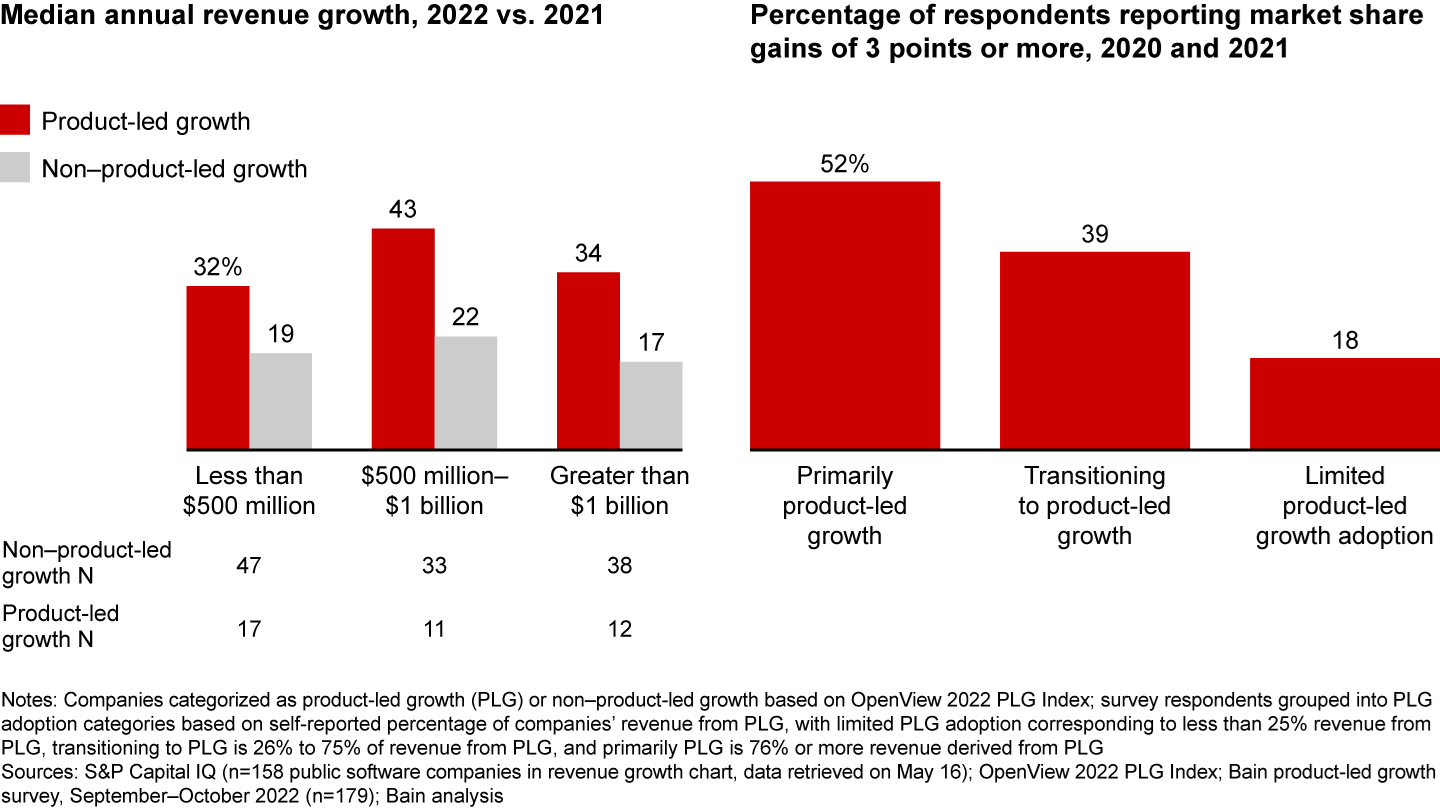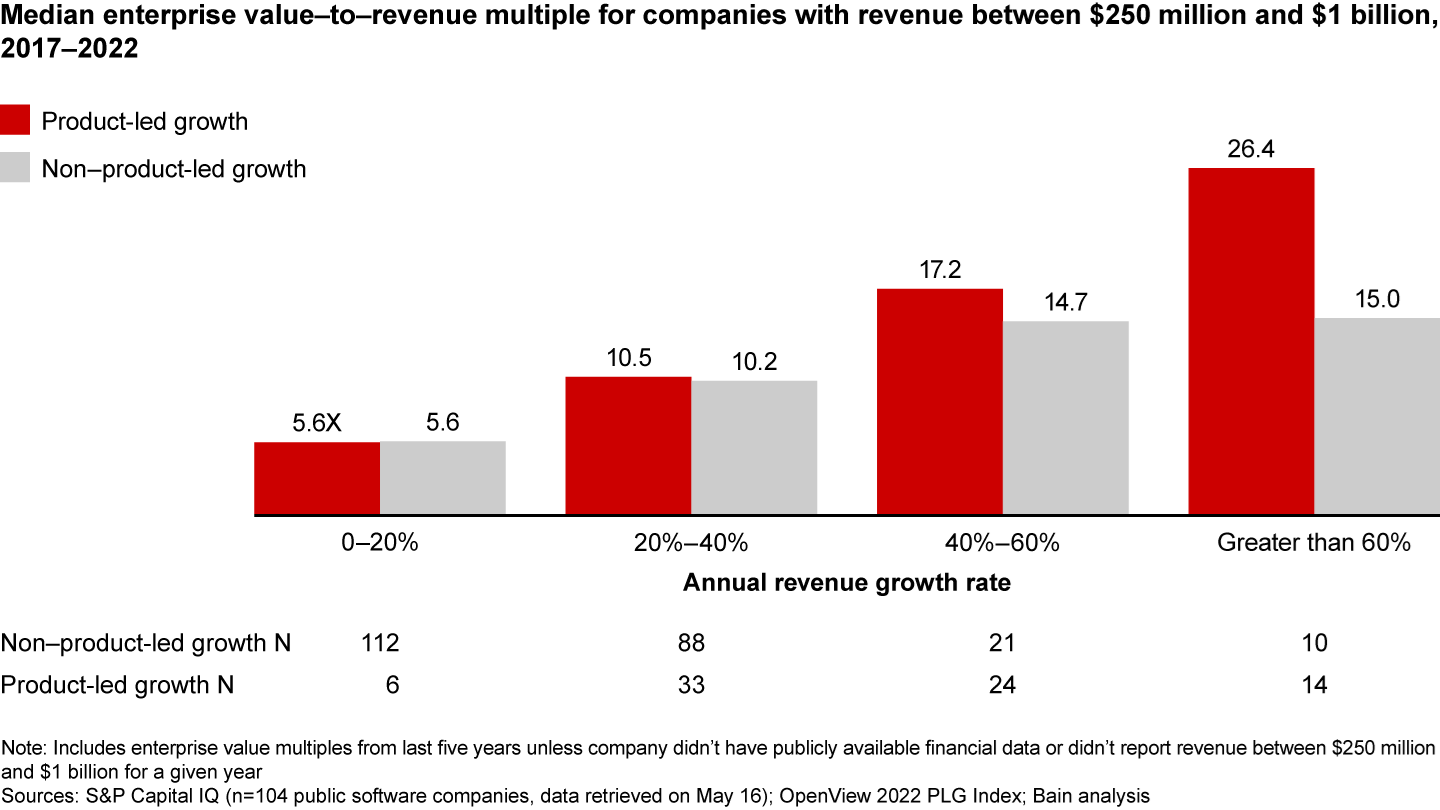Technology Report

In evidenza
- Software firms with a primarily product-led growth strategy increased their revenue in 2022 about twice as fast as those with little to no focus on product-led growth.
- Effectively integrating enterprise sales with product-led sales motions can accelerate revenue growth, but many companies struggle with this.
- Leading companies define thoughtful, data-based triggers for staff to engage with customers.
- Leading companies also develop clear strategies to foster collaboration among product, customer success, sales, and marketing teams.
- And finally, leading companies allocate resources intelligently and dynamically across product- and sales-led activities.
This article is part of Bain's 2023 Technology Report.
Despite the recent reset of technology sector valuations, product-led growth (PLG) software companies continue to outperform.
PLG has caught fire in software markets. It focuses on enabling end users to discover, try, buy, and scale up their usage in a self-service manner. Many companies adopt a PLG strategy from day one and add traditional sales-led commercial motions over time. Meanwhile, sales-led software companies can add a PLG motion or take a hybrid approach by applying the PLG model or capabilities to select parts of their product and customer portfolios—for example, relying on a sales team for the initial sale, then shifting to PLG self-service for renewals or expansions.
Firms that rely primarily on PLG increased revenue in 2022 nearly twice as fast as companies with limited or no PLG focus, and PLG companies are almost three times as likely to have gained market share over recent years (see Figure 1).
A product-led growth strategy produces faster revenue growth and greater market share


Furthermore, investors reward PLG companies with higher valuations, especially at higher revenue growth rates (see Figure 2). This remained true in 2022 despite the market correction.
Investors have rewarded primarily product-led companies with higher multiples at comparable revenue growth rates


PLG works best in markets where product configuration and deployment time are usually quick; end users can make purchasing decisions; the product is sticky, with usage growing over time; the potential customer base is broad, with lots of free users who can convert to paid users; and the product has features that entice users to upgrade to the next, higher-priced tier. (Read more in the January Bain Brief “What It Really Takes to Develop Product-Led Growth.”)
But in markets suited to PLG, what’s surprising is how many companies continue to struggle with the key to unlocking its full potential: enterprise sales. Nearly every PLG company adds an enterprise sales team at some point along their growth journey, but figuring out when and how best to integrate it—that is, maximizing value creation without undermining operational efficiency—often separates leaders from laggards in PLG.
Breaking through the ceiling
It may seem counterintuitive to integrate a live person into a business model tied to self-service. Nevertheless, getting end users to discover, sign up for, and engage with a product on their own can be challenging, especially if the product is complex or all its benefits aren’t obvious.
Plus, once PLG companies reach a critical mass of users, they often hit a revenue ceiling that’s tough to break through. As customer spending on an individual software vendor grows, the extra scrutiny and required budget approval by senior leadership can become roadblocks. And in some cases, larger customers may continue using suboptimal packages delivered via self-service that don’t provide the benefits required for large-scale deployment, leaving value on the table for both the software vendor and customers.
A dedicated sales team can help PLG companies move beyond one-off software purchases within enterprises and land bigger deals across the customer’s organization. It makes a huge difference having a salesperson proactively pitch to purchasing decision makers, address enterprise-grade requirements that an individual departmental buyer might overlook (e.g., cybersecurity and resilience), and coordinate the sales contract process required for larger spending levels. Sales, customer success, and support teams can also unlock new avenues of growth for both customers and vendors by helping end users scale up product usage beyond what they could do alone.
One PLG company increased its annual revenue growth rate by more than 5 percentage points in the two years after it launched an enterprise sales team. The company’s PLG motion supports bottom-up growth through customer success staff who serve as the frontline salesforce, targeting the most active users likely to convert others within their organization. And the enterprise sales motion supports top-down growth by engaging the largest, most promising accounts and providing centralized support for large-scale product integrations.
Integrating enterprise sales and self-service
Many companies have difficulty seamlessly marrying enterprise sales with a product-led sales motion. The product, customer success, sales, and marketing teams share ownership of the customer journey and touch the same customer experiences, so without well-defined connection points and an operating model that effectively integrates the distinct functions, companies will have trouble maximizing growth. Leading companies focus on three things.
- Defined triggers for a person to engage with a customer: Twilio brings in enterprise salespeople when an annual contract value reaches $100,000, and Dropbox does so when at least 3% of a customer’s employees already use its product. Some PLG companies take a more nuanced approach by passing along different accounts at different times based on the customer’s firmographic characteristics and behavior within the self-service platform. Sometimes, a customer’s first engagement point with a live person is with the enterprise sales team, while at other times, it could be customer success or even customer support, depending on the situation’s needs.
- Clear collaboration strategies: Product, customer success, sales, and marketing teams that support PLG can sit in different departments or in a single one. Several best practices apply to either model—namely, outlining distinct responsibilities across functions; transparently setting shared goals, metrics, and incentives; and establishing Agile ways of collaborating at the pace needed for PLG.
- Appropriate resource allocation: Leading companies thoughtfully tune their allocation of resources across product- and sales-led growth capabilities (including the mix of talent between the two motions) based on the strategic role PLG plays in their overall go-to-market approach.
Implications for key players
For entirely product-led companies, choosing the right time to add an enterprise sales motion is crucial. About 61% of PLG companies launch an enterprise sales team by the time they reach $50 million in annual revenue, according to a 2022 Bain survey.
There are usually clear indicators that enterprise sales could spur growth—for example, dips in converting enterprise users from free to paid subscriptions, having a low share of customers’ wallets, having a user base skewed toward small and midsize companies, or struggling to scale up the number of end users in segments with large potential for growth.
For enterprise sales–led companies transitioning to a PLG strategy, it’s important to recognize this is a major organizational transformation with long investment payback periods. Therefore, it requires strong C-suite sponsorship and a shift in mindset across the organization.
For investors, even in a tougher market, there are still strong opportunities in PLG if they can tailor their typical deal diligence approach to this sector’s distinct needs and characteristics. The investors that consider enterprise sales integration and effective cross-team collaboration when evaluating a PLG asset have a chance to achieve greater success in this increasingly attractive sector.